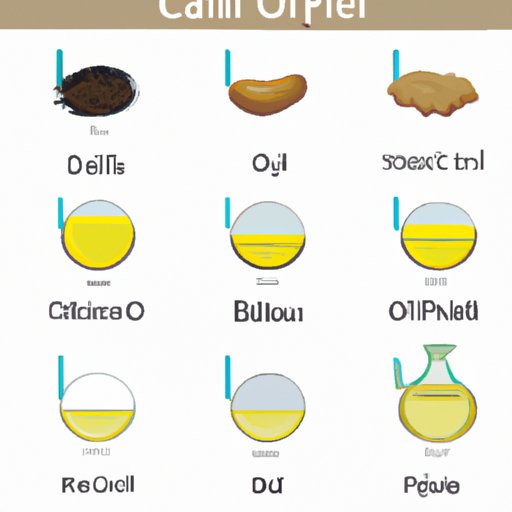Introduction
Cooking with oil can add flavor and texture to dishes, but not all oils are the same. Neutral oil is one type of oil that is commonly used in many recipes. But what exactly is it? And why should you use it? This article will explore these questions and provide a comprehensive guide to using neutral oil in your cooking.

Definition of Neutral Oil in Cooking
Neutral oil is a type of oil that has a mild flavor and does not interfere with other ingredients in a recipe. Unlike more strongly-flavored oils such as olive oil or nut oils, neutral oil does not have a strong taste or aroma. Because of this, it is often used as a base for salad dressings, sauces, and marinades. In addition, it can also be used for frying, roasting, and baking.
Benefits of Using Neutral Oil in Cooking
The main benefit of using neutral oil in cooking is that it does not add any additional flavor to the dish. This makes it ideal for dishes where you want the flavor of the other ingredients to shine through. Additionally, because it has a higher smoke point than other types of cooking oils, it is less likely to burn when used for high-heat cooking methods such as frying or sautéing. Finally, neutral oil is relatively inexpensive compared to other types of cooking oils, making it a budget-friendly option for home cooks.

A Guide to Neutral Oils for Cooking
There are several types of neutral oils available for cooking, each with its own pros and cons. Here is a quick overview of some of the most common types of neutral oil:
Canola Oil
Canola oil is made from the seeds of the canola plant. It has a mild flavor and a high smoke point, making it ideal for deep-frying or stir-frying. Canola oil is also relatively inexpensive, making it a popular choice for home cooks.
Grapeseed Oil
Grapeseed oil is made from the seeds of grapes and has a light, nutty flavor. It has a high smoke point, making it suitable for high-heat cooking methods such as frying. Grapeseed oil is also rich in antioxidants and omega-6 fatty acids, making it a healthier option than some other types of cooking oils.
Avocado Oil
Avocado oil is made from the flesh of avocados and has a mild, nutty flavor. It has a high smoke point and is rich in healthy fats, making it a popular choice for high-heat cooking such as frying or sautéing. Avocado oil is also relatively expensive compared to other types of cooking oils.
Vegetable Oil
Vegetable oil is a blend of different types of vegetable oils, such as soybean oil, corn oil, and sunflower oil. It has a mild flavor and a high smoke point, making it suitable for high-heat cooking methods. Vegetable oil is also relatively inexpensive compared to other types of cooking oils.
The Difference between Neutral and Non-Neutral Oils
Neutral oils have a mild flavor and do not interfere with the flavors of other ingredients in a recipe. Non-neutral oils, such as olive oil or nut oils, have a stronger flavor and can overpower the flavors of other ingredients. Additionally, non-neutral oils tend to have a lower smoke point than neutral oils, making them less suitable for high-heat cooking methods.

How to Choose the Right Neutral Oil for Your Recipes
When choosing a neutral oil for your recipes, there are several factors to consider. First, consider the type of dish you are preparing and the cooking method you will be using. For example, if you are roasting vegetables, you may want to use an oil with a higher smoke point, such as canola oil or grapeseed oil. If you are baking, you may want to opt for a lighter oil such as avocado oil or vegetable oil.
In addition, you may also want to consider the health benefits of different types of oil. For example, avocado oil and grapeseed oil are both high in healthy fats and antioxidants, making them a healthier option than vegetable oil.
Creative Ways to Use Neutral Oil in Cooking
Neutral oil can be used in a variety of dishes, from roasted vegetables to fried foods. Here are some creative ways to use neutral oil in cooking:
Roasting Vegetables
Neutral oil is perfect for roasting vegetables because it has a high smoke point and will not interfere with the natural flavors of the vegetables. To roast vegetables, simply toss them in a bowl with a few tablespoons of neutral oil, seasonings, and salt. Spread the vegetables on a baking sheet and roast in a preheated oven until golden brown.
Baking
Neutral oil is also great for baking. It adds moisture and helps create a tender, flaky texture in cakes, cookies, and other baked goods. To use neutral oil in baking, simply substitute it for butter or another type of oil in your favorite recipes.
Frying
Neutral oil is ideal for frying because of its high smoke point. To fry food, simply heat the oil in a pan over medium-high heat. Once the oil is hot, add the food and cook until golden brown.
Sauteing
Neutral oil is perfect for sautéing vegetables, meats, and other ingredients. To sauté, heat the oil in a pan over medium-high heat. Add the ingredients and cook, stirring occasionally, until the vegetables are tender and the meat is cooked through.
Conclusion
Neutral oil is a versatile cooking oil that can be used in a variety of dishes. It has a mild flavor and a high smoke point, making it ideal for high-heat cooking methods such as frying or sautéing. Additionally, it is relatively inexpensive compared to other types of cooking oils, making it a budget-friendly option for home cooks. With this comprehensive guide to neutral oil in cooking, you can now confidently choose the right type of oil for your recipes.


